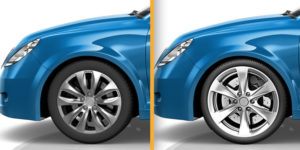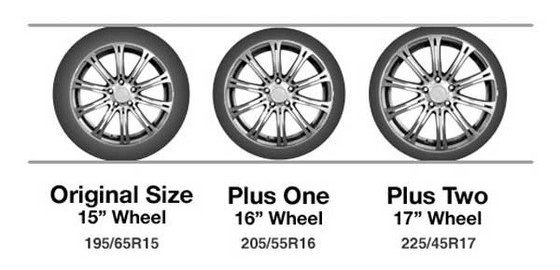Upsizing or Downsizing Rims
You may have noticed that the same car can have many different rims sizes. For example, you have 18″ wheels in the summer and 16″ wheels in the winter. This is called “downsizing” when installing wheels that are smaller than the factory set up and “upsizing” is when installing wheels larger than the factory set up.

DOWNSIZING
Generally, downsizing is done in the winter season. There are a few reasons/benefits for this:
- A smaller rim allows for a thicker side profile of the tire. This makes the tire less stiff and absorb more shock. This also means more distance between the edge of your rim and the ground to protect your rim if the car slides in to a curb.
- The smaller rim allows for a narrower tire width. The narrower your tire is, the less snow it has to plow and cut through for the rubber to make contact with the road. It also gives you more weight per square inch. All of this totals better traction.
- Generally, tires for smaller rim sizes are less expensive.
UPSIZING
Upsizing is mostly practical in the spring/summer season. Here are the benefits:
- Larger rims allow for the installation of low profile tires and are more aesthetically pleasing to the eye.
- The handling is better on a wider tire in conditions without snow.
- Many low profile tires have the classic “v” shape tread pattern which is best suited for water displacement or prevention of hydroplaning.
PRINCIPLES BEHIND UPSIZING AND DOWNSIZING
It is perfectly fine to do it as long as you are understanding the pros and cons to up or down sizing. There are a few simple principles to understand to be sure you are avoiding issues that can arise from doing so.
1. OVERALL TIRE DIAMETER – The rim size is not as important as calculating the overall tire diameter. The vehicle RPM, engine timing and even gas mileage is tuned to your factory tire diameter. You must remain within 3% of the original total diameter when changing to a tire size other than the original specs to maintain these functions. If you measure your tire from the bottom of the ground to the top of the tire, this would be the total tire diameter. If your tire is 30″ for instance, that means you can go with a tire size 3% higher or lower as a general rule of thumb. In this case, that means staying within a tire that is between 29.13″-32.9″. That being said, going with a larger or smaller tire is not the right way to change the ride height of a car. This would require installing lowering springs or lift kits to the suspension.

2. RIM FITMENT– Although the most important factor is the overall tire diameter, you must ensure the rim size you are choosing is one that fits without issues. Such problems that can arise are wheels that physically make contact with the fender, brake caliper, or suspension components like the shocks. Not all cars have the same bolt pattern, either. You have to be sure that the holes on the rim line up with the studs on the car. It is important to note that if the rim fits okay, you still have to be careful not to choose a tire that is too wide, either.




